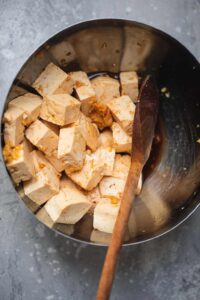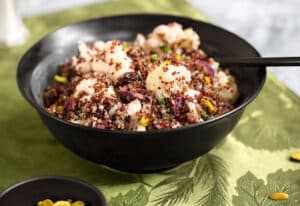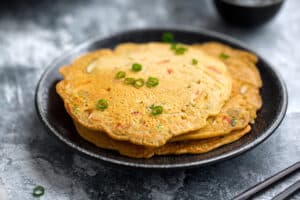Contributed by Aimable Johnson. Quinoa is a food that has been embraced by the health food crowd. A ‘superfood’ grain from South America, it has become extremely popular due to its numerous uses. With quinoa established, now it’s time to meet its cousin, kañiwa.
Hailing from the same region, grown in Peru and Bolivia, kañiwa is the smaller, darker and sweeter seed that is rising to work side by side with quinoa on the health food market.
Kañiwa is marketed as a whole grain, but it is actually a seed from a flowering plant called goosefoot. It resembles a much smaller, dark reddish-brown quinoa in appearance. Part of the staple diet of the local population of the Andes for generations, it’s only recently been discovered by Western civilizations.
While the recent spread of kañiwa means that it hasn’t yet been extensively studied, the nutritional facts already discovered are placing it on par with its’ cousin, quinoa.
The Perks of Kañiwa
If you’re looking for something high in protein and fiber in a single package, kañiwa is a fantastic choice. Containing more protein than its cousin quinoa, (16% as compared to quinoa’s 13%) kañiwa offers the same high quality of protein, with notable amounts of the essential amnio acids.
Lysine, usually available only in small amounts in grains, is significantly present in kañiwa. It also has the additional perk of offering a higher amount of iron (60% to quinoa’s 15%.)
Kañiwa is naturally gluten-free, which is fantastic for people who are looking to reduce the amount of gluten in their diet.
Additional good news for people looking to create a gluten-free diet is the fact that kañiwa carries the same B vitamins and minerals as whole-grain wheat.
Kañiwa’s PDV (Percent Daily Values) of protein, carbohydrates and minerals are extremely high, allowing this seed to be a staple in any diet.
With very little crude fat content, it’s a safe choice for those who are looking to maintain their protein count. A single 3.5 ounce serving of kañiwa seeds holds 31% of the fiber recommended in PDV calculations.
One of the shining features of quinoa is the fact that it contains flavonoids, a type of antioxidant. This is where kañiwa steps above quinoa.It contains more flavonoids than quinoa, particularly isorhamnetin and quercetin. These specific flavonoids have been established as helping reduce the risk of certain inflammatory diseases and aid in cardiovascular health.
Being a plant food, it is completely lacking in saturated fat and is cholesterol-free. It provides protein, iron, vitamin B, minerals, fiber and antioxidants in a single serving.
Now that it’s clear adding kañiwa to a diet will give incredible benefits, how can it be used?
Kañiwa in Your Kitchen
With all of the nutritional value, kañiwa has another gift to give. Unlike quinoa, this seed does not contain any saponins which give some foods a bitter, soapy flavor. Quinoa has to be rinsed very well before it’s cooked and eaten; kañiwa lacks those saponins and it’s not as tricky to prepare.
To extract the maximum flavor from kañiwa, it’s recommended to toast the seeds before cooking. This only requires about 2 to 3 minutes in a dry skillet over medium heat, stirring the seeds thoroughly to ensure an even toasting.
Cooking kañiwa is similar to any other whole grain; in a 2:1 ratio of water (for every cup of kañiwa, use 2 cups of water) the kañiwa is simmered for 15 to 20 minutes until the seed is soft and the liquid has been absorbed.
It can also be cooked in a crockpot on high for a minimum of two hours. One cup of dry kañiwa will yield an average of 2 cups cooked.
Kañiwa itself has been described as having a nutty, mild and slightly sweet flavor, similar to that of quinoa. It doesn’t ‘fluff’ in the way that quinoa does, but it also does not congeal like millet.
With the kañiwa prepared, a range of dishes is available to incorporate the seed. It has a very quick cooking time, so it can be added to stir fry, soups and stews to thicken the dish.
Kañiwa can replace rice as a grain bed for stir fry vegetable dishes. It pairs well with tofu for an extremely hearty lunch, and it can be cooked with nondairy milk for a breakfast porridge. Add a handful of raisins or chopped nuts with a little sweetener of your choice and it creates a filling start to the day.
Stored in a sealed plastic or glass container, preferably in a cool, dark and dry cabinet, kañiwa will stay fresh for one year.
Grind It Down!
Whole kañiwa lends itself to any number of delicious dishes, but there’s another benefit to this seed.
It can be ground down into a flour as well. With its high protein density, kañiwa does not bake well by itself for pastry products or breads.
This doesn’t mean that kañiwa cannot be used for baked goods. Just as adding whole-wheat flour to an unbleached flour can give a batch of cookies a heartier flavor, so can kañiwa flour boost a baked good.
It’s best to start with a quarter cup of kañiwa flour added to most recipes, avoiding the need to adjust liquids and providing that little punch of flavor. As it’s dark in color, kañiwa flour works best in darker baked goods where a change in coloration won’t be detrimental.
If a baker already substitutes a certain amount of recommended flour with a healthier choice, kañiwa flour can take the place of the addition.
For a hearty dark Pumpernickle bread or a sturdy gingerbread, kañiwa flour is a fantastic choice. It can also work for pancakes and waffles, providing another form of a healthy breakfast choice.
Add kañiwa flour to a batch of muffins and top them with honey for a delicious and extremely healthy snack. This versatile seed can even be made into a hot drink similar to hot chocolate.
The Rising Kañiwa Star
A single addition to any health-conscious kitchen, kañiwa’s benefits and easy preparation make it a contender for the title of ‘superfood.’ This seed is deserving of great attention and is gaining that in leaps and bounds.
Although kañiwa is not as readily available as quinoa, due to its recent appearance on the market, numerous health food markets are beginning to stock it regularly.
While its limitations in baking means kañiwa can’t replace grain flours entirely, the versatility of kañiwa in whole seed and flour form ensure that it will be a purchase worth the money. Currently, kañiwa is more expensive than quinoa, but this is due to the limited availability.
As kañiwa grows in popularity, it will likely match quinoa cent for cent and pound for pound in consumer usage. Kañiwa is available in most supermarkets and health food stores.
Article by Aimable Johnson, from Dieting Well.
- Learn more about kañiwa — How to Cook and Use this "new" ancient super grain.






Tribawan kaul says
what is botanical name of kaniwa, any pics of the plant?
Linda says
Great information! I bought some but didn't know how to use it.